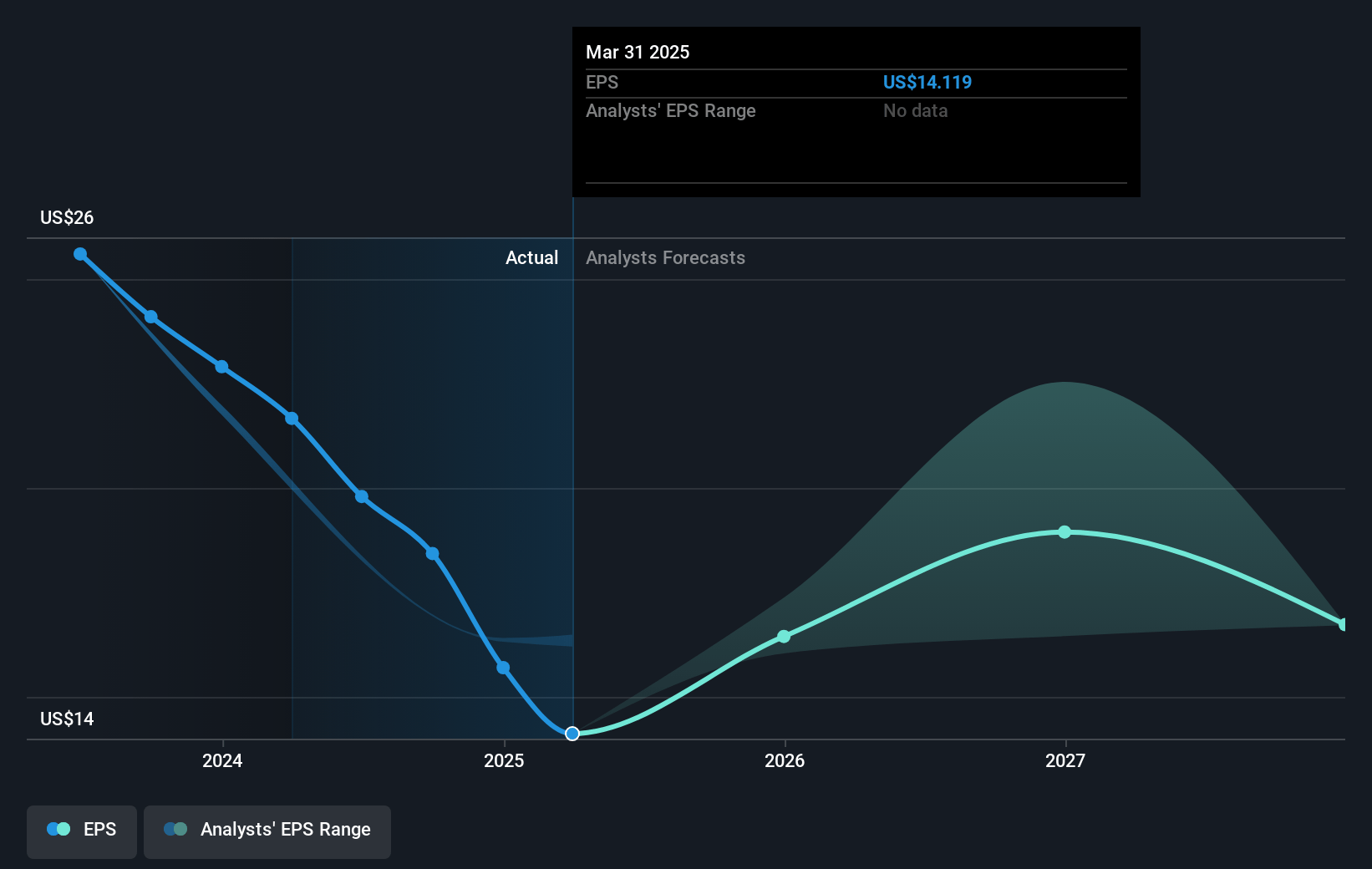Key Takeaways
- Slowing semiconductor demand and excess inventories risk revenue growth, with further pressure from declining selling prices and persistent uncertainties.
- High capital expenditures and acquisitions may increase leverage or strain cash flow, affecting margins if synergies fail to emerge promptly.
- Reliance's strong cash flow, acquisition strategy, and diversified business model enhance revenue growth and stability, while their financial flexibility supports ongoing strategic investments.
Catalysts
About Reliance- Operates as a diversified metal solutions provider and the metals service center company in the United States, Canada, and internationally.
- The slowing global semiconductor demand and continued excess inventories in the supply chain could dampen revenue growth, with signs only of stabilization rather than recovery.
- There is expected to be a decline in average selling price per ton sold in the fourth quarter, which is likely to impact both revenue and net margins negatively.
- Continued macroeconomic and political uncertainty, including delayed infrastructure projects due to permitting slowdowns and labor shortages, may hinder future revenue growth in key sectors like construction and manufacturing.
- The company's reliance on LIFO inventory valuation, with a year-end true-up based on inventory levels, could lead to compressed earnings if inventory values don't sync well with replacement costs or product mixes change.
- Planned capital expenditures and the continuation of high acquisition activity could lead to increased leverage or require more cash flow, potentially affecting net margins and overall earnings if synergies from these activities do not materialize quickly.
Reliance Future Earnings and Revenue Growth
Assumptions
How have these above catalysts been quantified?- Analysts are assuming Reliance's revenue will decrease by 0.9% annually over the next 3 years.
- Analysts assume that profit margins will shrink from 7.4% today to 6.2% in 3 years time.
- Analysts expect earnings to reach $890.3 million (and earnings per share of $16.03) by about January 2028, down from $1.0 billion today.
- In order for the above numbers to justify the analysts price target, the company would need to trade at a PE ratio of 24.3x on those 2028 earnings, up from 15.2x today. This future PE is greater than the current PE for the US Metals and Mining industry at 16.5x.
- Analysts expect the number of shares outstanding to grow by 0.87% per year for the next 3 years.
- To value all of this in today's terms, we will use a discount rate of 7.24%, as per the Simply Wall St company report.
Reliance Future Earnings Per Share Growth
Risks
What could happen that would invalidate this narrative?- Reliance Inc.'s strong cash flow generation and effective working capital management allow them to continue executing their capital allocation strategy, including significant investments in growth activities, which could positively impact revenue and future earnings.
- The company's successful acquisition strategy, with four acquisitions in 2024 and an active M&A pipeline, supports product diversification and value-added processing capabilities, potentially leading to improved revenue and net margins.
- Reliance's diversified business model and strategic investments enable them to outperform industry shipments, even in challenging market conditions, suggesting resilient revenue streams and stable gross profit margins.
- The semiconductor market shows signs of stabilization, and with Reliance's positive long-term outlook, demand recovery could enhance revenue contribution from this segment.
- With a robust balance sheet and low net debt-to-EBITDA ratio, Reliance has financial flexibility to pursue further growth opportunities and strategic priorities, which may positively affect future earnings.
Valuation
How have all the factors above been brought together to estimate a fair value?- The analysts have a consensus price target of $318.53 for Reliance based on their expectations of its future earnings growth, profit margins and other risk factors. However, there is a degree of disagreement amongst analysts, with the most bullish reporting a price target of $338.0, and the most bearish reporting a price target of just $272.0.
- In order for you to agree with the analyst's consensus, you'd need to believe that by 2028, revenues will be $14.4 billion, earnings will come to $890.3 million, and it would be trading on a PE ratio of 24.3x, assuming you use a discount rate of 7.2%.
- Given the current share price of $292.68, the analyst's price target of $318.53 is 8.1% higher. The relatively low difference between the current share price and the analyst consensus price target indicates that they believe on average, the company is fairly priced.
- We always encourage you to reach your own conclusions though. So sense check these analyst numbers against your own assumptions and expectations based on your understanding of the business and what you believe is probable.
How well do narratives help inform your perspective?
Disclaimer
Warren A.I. is a tool utilizing a Large Language Model (LLM) that ingests data on consensus price targets, forecasted revenue and earnings figures, as well as the transcripts of earnings calls to produce qualitative analysis. The narratives produced by Warren A.I. are general in nature and are based solely on analyst data and publicly-available material published by the respective companies. These scenarios are not indicative of the company's future performance and are exploratory in nature. Simply Wall St has no position in the company(s) mentioned. The price targets and estimates used are consensus data, and do not constitute a recommendation to buy or sell any stock, and they do not take account of your objectives, or your financial situation. Note that Warren A.I.'s analysis may not factor in the latest price-sensitive company announcements or qualitative material.
Read more narratives
There are no other narratives for this company.
View all narratives



